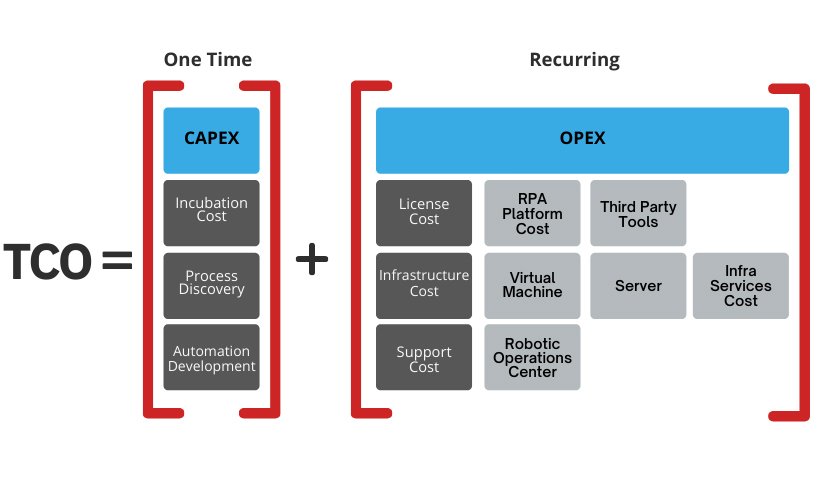Expert Insights
The True Cost of Excluding RPA from Your Business Operations
Do the savings delivered by RPA projects surpass the total cost of ownership?
One question we often come across in the early stages of client automation projects is the total cost of ownership for RPA, which the business must determine beforehand in order to calculate the project’s eventual return on investment. With interest around automation growing at an exponential rate in the past three years alone, it is reasonable that business and IT leaders across all industries, while excited about the technology, may still be skeptical of the costs of RPA in relation to the value delivered.
Total Cost of Ownership
We have extensively discussed the benefits of RPA and why it should be a major initiative in digital transformation strategy for companies of all sizes. Measurable benefits include reduced operational costs, faster turnaround times, ability to process higher volumes of work, and peak time adjustments. But how does the business value measure up to the costs? To determine whether RPA is a sound investment, a good calculation to apply is FTE Cost Reduction Minus Cost of Automation Development, or Business Benefits Minus Total Cost of Ownership.
We can calculate the total cost of RPA by adding the one-time fees to the recurring or operating expenses, detailed in the chart here. Once you have calculated the total cost, you can compare it to the tangible value delivered to determine how much an automation project is costing your business.

The Costs of NOT Automating
When calculating the costs associated with RPA implementation, businesses should also consider the costs of not automating. Technical debt can be incredibly costly, and businesses hesitating to leverage the power of RPA could be racking up major hidden expenses stemming from growing inefficiencies and wasted resources.
The costs of excluding RPA from your business strategy include:
- Reduced productivity
- Increased security and compliance risk
- Operational inefficiency
- Customer dissatisfaction
- Increased labor costs
The human cost of excluding automation should also not be overlooked. When companies stall on RPA adoption, the change management process tends to be more disruptive, burdensome, and time-consuming, making it more challenging in the long run for affected employees to accept the technology as a regular part of daily operations. According to a 2020 McKinsey survey, over 70% of change-affected workers reported experiencing moderate to high stress levels. What can business leaders take away from this? From an operational efficiency standpoint, waiting to implement RPA can cost an enterprise more in the long run. Institutionalizing an “automation mindset” and having employees only go through a single round of change management is a more effective strategy than implementing RPA with a piecemeal approach and having the business undergo multiple change management initiatives that only impede employee assurance and productivity.
Measuring RPA Project Value
When trying to calculate the value delivered by RPA, the strategic returns from future business and technical options made possibly by the technology are not always easily measurable. RPA can deliver many intangible benefits like improved employee retention, leaner teams, richer data quality, better communication across teams, improved compliance (and therefore reduced remediation efforts), and improved customer experience.
While our clients have seen staggering ROI across many metrics (those in the financial services industry, for example, have seen 30-60% in cost savings – click here to learn more), RPA success criteria will vary based on the client’s business goals. We have worked with enterprises whose main motivators were time savings, while others measure the value of RPA by the percentage of work being automated or the elimination of redundant work.
We worked with a Major Financial Investment Firm that handled approximately 3 million customer calls per year through its client service centers. To handle a single client request call, a CSR had to manually pull up 15+ client attributes from two systems while on the call, access a macro enabled Excel file, input the data, and perform the necessary calculations to determine whether the requested loanable value was applicable to the client. We developed and implemented an attended automation to gather all the relevant client and plan data into a readable workbook for the CSR during the call, enabling the CSR to focus more on the customer needs and resulting in a 92.5% reduction in call duration. For this client, the value of automation was proven through their immense time savings and significantly improved customer satisfaction rates.
For an American Auto Insurance Agency, a team of ten employees were processing 800+ policy discounts manually each day. Accelirate created an automation capable of managing and updating the internal policy system to apply the discounts automatically as the Insurance Agency receives them. Since this client’s primary business goal was FTE reduction, the value of automation was demonstrated by the automation eliminating the manual labor required for this task and the ability to process a day’s worth of policy updates in one third of the time it would take a human employee.
One Healthcare client was interested in using RPA to improve compliance. Accelirate developed several automations for the client to streamline ICD-10 code changes, claims processing, billing, and patient data input and syncing. By using automation to eliminate human error and improve data quality and security measures, the client had the certainty of knowing their operations were HIPAA compliant, saving them potential millions in legal fees.
Justifying the costs of automation may seem daunting, but investing in the technology and its long-term outcomes has been effective across industries in building an enterprise’s competitive advantage while keeping the business prepared for market changes. Positioning your business to outperform competitors is invaluable; the time to automate is now.